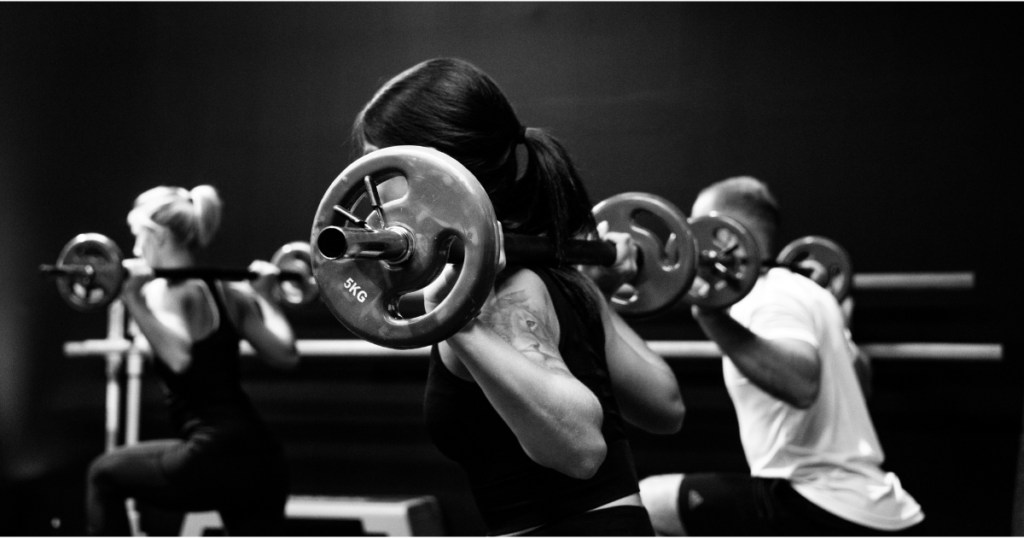In this clicking age, health and fitness are simply inevitable for dwelling a good quality of life. Physical fitness implies an exercise program to enhance the condition of the mind and emotions along with physical well-being. A good-rounded fitness regime must include all four types of exercise-aerobic training, strength training, flexibility, and balancing exercises. The following article discusses them along with what is their importance and how they contribute to overall physical fitness.
What are the Four Types of Exercise for Optimal Fitness?
Understanding Aerobic Exercises
Aerobic exercise is commonly regarded as cardiovascular exercise that requires the heart to pump the blood slightly faster than it does normally. With an increase in heart activity and blood flow, oxygen circulation improves throughout the body. Some aerobic activities are running, swimming, and cycling. With such activities, you could see great improvements in your endurance and cardiovascular health. The National Institute on Aging proposes for adults a minimum of 150 minutes of moderate aerobic activity each week for inducement of impact. Aerobic exercise burns calories, strengthens the heart and lungs, and reduces chronic diseases such as heart condition and diabetes.
The Importance of Strength Training
Strength training is another vital component of the four types of exercise. This type of exercise focuses on building muscle mass and improving muscular strength through resistance activities. Common strength exercises include squats, push-ups, and weight lifting. As we age, maintaining muscle mass becomes increasingly important to prevent injuries and support joint health. Incorporating strength training into your routine at least two times a week can enhance your muscle strength, boost metabolism, and improve overall physical performance. Furthermore, strength training can also play a crucial role in preventing falls, especially among older adults, by enhancing balance and stability.
How Flexibility Exercises Enhance Physical Fitness
Flexibility exercises are often overlooked but are essential for maintaining an optimal fitness regime. These exercises focus on extending the range of motion of your joints and muscles, which can reduce the risk of injuries and improve overall physical performance. Activities like yoga, stretching, and Pilates are excellent examples of flexibility exercises. Regularly incorporating flexibility training into your routine can enhance your athletic performance, alleviate muscle tension, and improve posture. Additionally, a well-rounded fitness program that includes flexibility exercises can lead to better recovery after workouts and a more enjoyable exercise experience overall.

How Does Endurance Exercise Benefit Your Health?
What are Effective Endurance Exercises?
Endurance exercises involve activities that make your heart pump more blood through your body over a longer period. They are essential for building your base fitness and include exercises such as running, cycling, swimming, and walking briskly. All these exercises help in improving the efficiency of your cardiovascular system and increasing your stamina to make your daily activities easy to do. But when looking at endurance workouts with the benefits of physical activity, they help improve an individual’s mood and energy level, thanks to the endorphins released into the human system as a result of prolonged activity.
For How Long Should You Endure Exercise?
The general recommendation for securing solid health benefits from endurance exercises is at least 150-minutes of moderate-intensity aerobic activity per week. These can, moreover, be broken down into smaller sessions, such as 30 minutes a day, five days a week, but one can also engage in active, high-range activities for shorter periods and still gain the same health benefits. The key is finding the right balance for you to fit into your lifestyle and current fitness levels to make it easy to consistently stick to the exercise routine.
Building Endurance for Older Adults
Endurance training for the elderly serves as a way to have a better heart and overall physical well-being while reducing their risks for endangering chronic diseases. The recommended endurance-acquiring activities for older adults are walking or swimming since these are less-impact activities and may cause little or no injury. As people age, they must be more sensitive to their bodies and take the guidance of a health professional in initiating a new work-out program. They can incorporate activities such as tai chi to promote balance and endurance as part of their program for older adult fitness.
What is Flexibility in Exercise?
Stages of Flexibility Exercises
Flexibility exercises can basically be divided into two types: static and dynamic. Static flexibility exercises require holding a stretch for a given period. For example, holding a hamstring stretch or a quadriceps stretch. On the other hand, dynamic flexibility exercises consist of movement involving stretching the muscles while the body is in motion, such as leg swings or arm circles. Including both types of flexibility exercises in your routine will help you to keep a healthy range of motion in your joints crucial for your physical activities.
Ways to Incorporate Flexibility Exercise into your Daily Routine
It is very easy to include flexibility exercise in your routine. Dedicating a few minutes at the end of a workout to perform static stretches with all major muscle groups is a very effective way of integrating flexibility exercise into one’s routine. Consider dynamic stretches before engaging in other types of exercises during warm-up. In fact, make flexibility exercises part of your routine physical activities. They improve your all-round fitness and will prevent muscles from getting stiff.

Benefits of Improved Range of Motion
A broader range of motion can be acquired through flexibility exercises and will provide you benefits such as enhancing performance as an athlete, decreasing injuries, and better postural alignment. The wider your range of motion, the more proficient you will be able to execute movement patterns, thus improving your performance in strength training and aerobic exercises. Flexibility, exercise, and muscle spasm release also have a component that can increase circulation and bring forth relaxation, all of which add to health.
Importance of Strength Training in Physical Fitness
Essential Strength Training Exercises That Help in Building Muscle Mass
An intensive strength training program aims at all muscle groups for developing both strength and muscle mass. These exercises include squats, deadlifts, bench presses, and lunges. Each exercise is capable of working three or four muscles simultaneously. Therefore, these should be included in your workout routine not only for aesthetic but also functional development of your body. Strength improves the function of your body’s muscles when dealing with daily undertakings.
Ways Strength Training Prevents Injury
Strength training is shown here as having a clear and direct effect on injury prevention in the process of strengthening the muscles, tendons, and ligaments that provide support for the musculature around the joints. A well-structured strength training program improves muscle imbalance and stability, thus improving overall functional fitness. All these changes would be made with pure concentration on muscle strength in the lieu of injury reduction in every activity, workout or lifestyle.
Strength Training for Older Adults: Tips and Techniques
It turns out that strength training, in fact, can be extremely beneficial for older adults. They should start with light weights and concentrate on the proper form for safety and effectiveness. Using resistance bands and bodyweight exercises can also be included to start gradual introduction to strength training. Also, older adults should consult fitness professionals who can help create a specific program tailor-made to meet individualized needs and fitness levels. Consistent exercise is the key although small gains in strength can deliver health and holistic advantage.
Effect of Balance Exercises on Fitness
Types of Balance Exercises
Stability and coordination are the most important factors concerning fitness; hence, balance exercises are important. Balance exercises include single-leg stands, heel-to-toe walks, and ball movements with the stability ball. Balance exercises put the proprioceptive system of your body to use, or in other words, the one that keeps the balance and spatial orientation. Balance training will improve not only athletic performance but also daily activities.

Benefits of Balance Training for Older Adults
Balance training is very beneficial among the elderly since it prevents falls, which are the major factors predisposing them to injury. In fact, the improvements in balance can be translated into confidence in mobility, thereby enabling the physically active participation of older people in activities without fear. Other examples of activities one can pursue include tai chi and yoga, which have proved good for balance coordination.
Include Balance Exercises within Your Routine
In fact, practice it with the use of balance exercises as part of your daily routine: Such practices as brushing your teeth and standing on one leg for a few minutes in your day completing with heel-to-toe walks will develop your balance remarkably. All it needs is consistency and progressing to more difficult balance activity with time. In the end, you will see a difference in physical fitness and movement confidence over time.
FAQS:
Q: What are the different types of fitness and why are they important?
A: The different types of fitness include cardiovascular, muscular strength, flexibility, and balance. Each type plays a crucial role in overall health and helps improve different areas of physical performance.
Q: How does cardiovascular exercise benefit my health?
A: Cardiovascular exercise helps improve heart rate and breathing, increases endurance, and can reduce the risk of chronic diseases such as type 2 diabetes. Engaging in activities like running, cycling, or swimming can significantly enhance your cardiovascular health.
Q: What types of exercises are considered muscular strength training?
A: Muscular strength training includes exercises like weight training, resistance band workouts, and bodyweight exercises such as push-ups and squats. These exercises are essential for building muscle and enhancing overall strength.
Q: How much exercise and physical activity do I need each week?
A: It is recommended to engage in at least 150 minutes of physical activity per week, which can include a mix of cardiovascular and muscular strength exercises. This amount of activity helps maintain overall fitness and health.
Q: Can I combine different types of exercise to maximize my fitness?
A: Yes, combining different types of exercise, such as cardiovascular, muscular strength, and flexibility training, can help maximize your fitness and provide a well-rounded fitness routine. This approach can also help prevent boredom and reduce the risk of injury.
Q: What are some examples of endurance activities?
A: Endurance activities include exercises like running, cycling, swimming, and even brisk walking. These activities help improve cardiovascular health and stamina, making them essential for overall fitness.
Q: How can I incorporate weight training into my routine?
A: You can incorporate weight training into your routine by using free weights, machines, or bodyweight exercises. Aim to include weight training at least two times a week to help improve muscular strength and overall fitness.
Q: Is it necessary to consult a physical therapist before starting a new exercise program?
A: While it is not always necessary, consulting a physical therapist can be beneficial, especially if you have existing health concerns or injuries. A physical therapist can help design a safe and effective exercise program tailored to your needs.
Q: How do I know if I’m doing enough cardiovascular exercise?
A: You can assess your cardiovascular exercise by monitoring your heart rate and breathing during activities. If you are able to talk but not sing comfortably, you are likely in the right intensity zone. Aim for at least 150 minutes of moderate-intensity cardiovascular exercise each week.